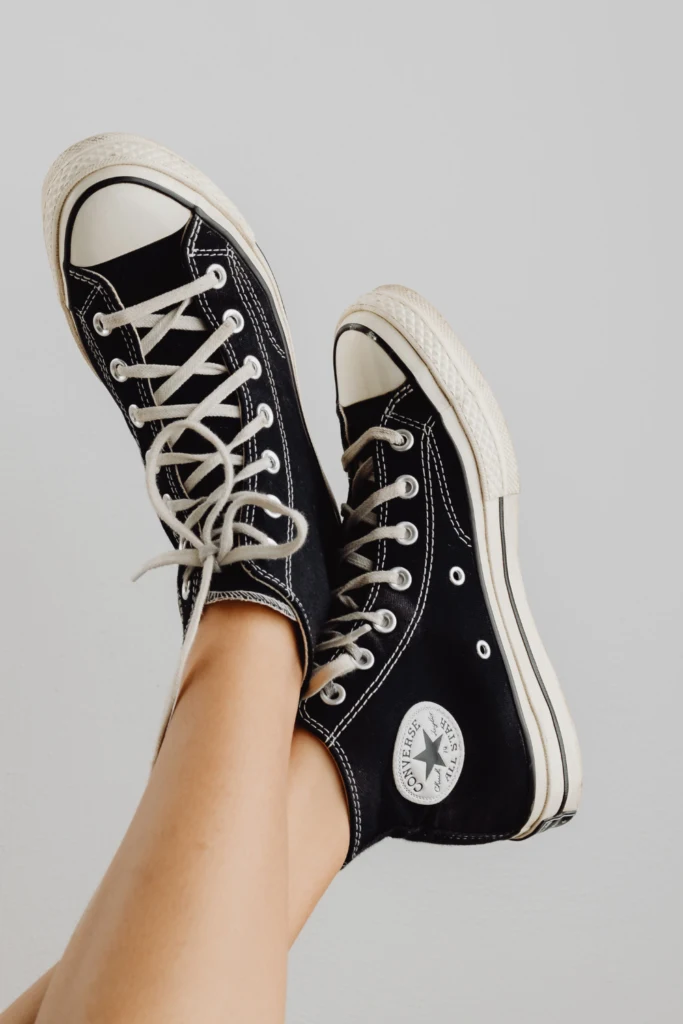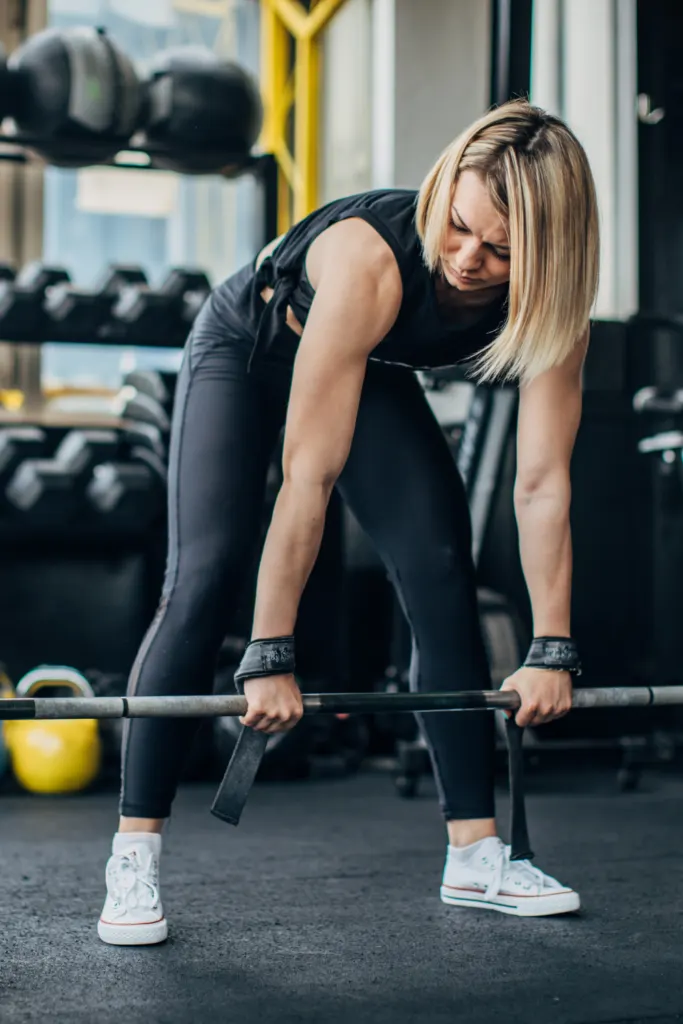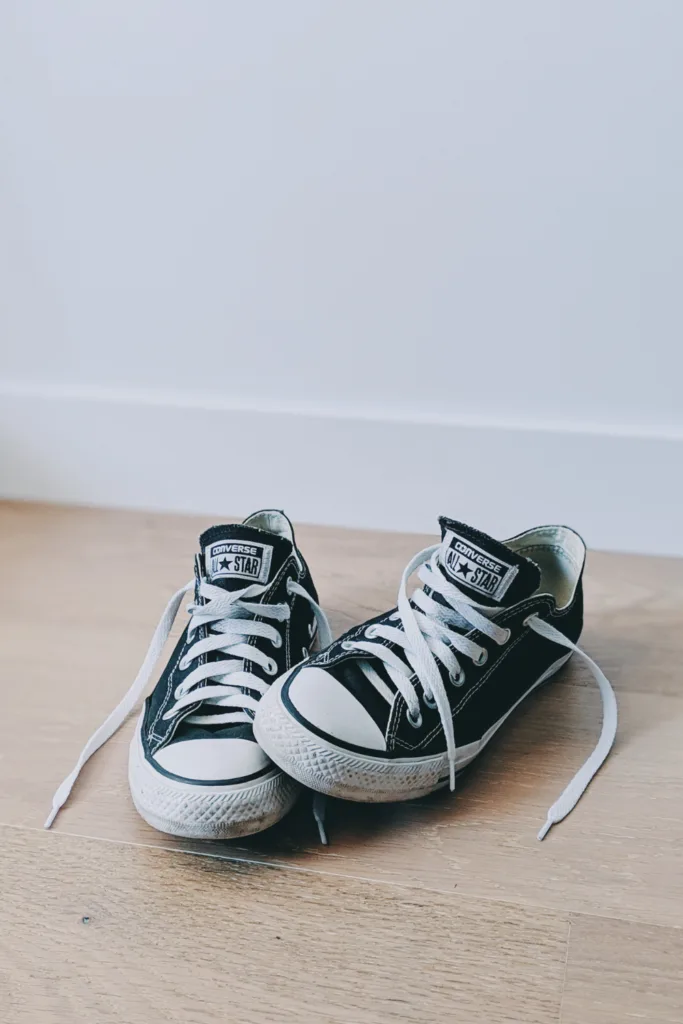Been to the gym recently? Then you may have seen people lifting weights wearing Converse shoes.
This begs the question: “Are Converse good for lifting?”
Or you may even be wondering: “Why do people wear Converse at the gym?”
People wear Converse to the gym for a variety of reasons – they’re comfortable and durable, and they look pretty damn stylish!
Converse also come in a variety of styles and colours, so it’s easy to find a pair that suits your tastes.
But why exactly do people wear Converse at the gym? Are Converse good for lifting?
I’ll provide answers to these questions in this guide.
We’ll look at:
- The history of the Converse shoe
- Are Converse good for lifting?
- Why are Converse good for lifting?
- How good are Converse for lifting?
- When should you avoid wearing Converse shoes?
- Best Converse shoes for lifting
Ready?
Let’s go!

The history of the Converse shoe
The first Converse shoe was created in 1908 in Massachusetts, USA.
Since then the company has gone on to produce and sell millions of shoes worldwide.
Charles “Chuck” Taylor – a semi-professional basketball player – joined Converse in 1921 and made various improvements to the shoe, including enhancing the shoe’s flexibility and improving its ankle support.
During this time Converse also added the now iconic All-Star logo to the ankle patch.
In the years that followed, Converse All Stars – as they then became known – were worn by numerous professional basketball players.
The shoe even became the official shoe of the Olympic Games between 1936 and 1968 and the official athletic training shoe of the US Army in the Second World War.
By the 1950s, Converse were a wardrobe staple for many young Americans and professional basketball players.
Nike acquired Converse in 2003 and continues to sell the shoe in stores worldwide.
Converse today rank as one of the most recognisable and loved shoe brands in the world.
Related: Can you put shoes in the dryer? 7 running shoe cleaning do’s and don’ts
Are Converse good for lifting?
The simple answer – yes!
Although originally designed for basketball, Converse are considered a good beginner shoe for weightlifting and powerlifting.
This is because they have flat rubber soles that enforce correct posture on movements such as squats, deadlifts and bench presses.
Flat sole shoes allow you to push off the ground much more easily and crucially remain balanced when doing exercises like squats and deadlifts.
If you wear a shoe with a cushioned heel when lifting, like a running shoe, you are more at risk of losing your balance.
Most gym shoes are designed as running shoes which are ideal for activities like running on the treadmill.
These shoes typically have cushioned soles to provide the necessary comfort and stability and support proper running form.
Running is a high impact sport so it’s vital you have the right running shoes to protect your feet.
Still not convinced?
What if we told you that world champion powerlifter Laura Phelps Sweatt swears by her Chuck Taylors?
The evidence is out there: Converse have the potential to be a great lifting shoe.
Related: The best recovery shoes for runners: Oofos slides vs Hoka slides

The pros and cons of wearing Converse for lifting
Here are the pros and cons of wearing Converse for lifting.
Let’s first take a look at the pros:
#1 Pro: They’re comfortable
One of the best things about Converse shoes is that they’re stable and comfortable.
The simple, lightweight canvas design won’t weigh your feet down.
Professional lifting shoes can sometimes be uncomfortable to wear as they can lack flexibility in the sole in the mid-foot and forefoot.
Many people opt for Converse shoes because they are more flexible and mimic a barefoot experience – which is great for lifting!
#2 Pro: They’re durable
If you’re going to be spending money on a new pair of kicks, you want to have a clear expectation of how the shoes will perform over time.
Converse are one of the most durable shoes on the market thanks to the high quality canvas materials they are made with.
A pair of Converse will typically last between 12 to 48 months depending on footfall.
Although it’s not uncommon for a pair of Converse shoes to hold up much longer – results of course will vary person to person.
As with most shoes, proper care and cleaning is needed to make them last for longer.
It’s also recommended you keep them dry and avoid wearing them on difficult terrain.
All Converse shoes come with a manufacturer’s warranty, so if you do experience any issues, Converse will happily replace them for you.
#3 Pro: They’re easy to clean
One of the best things about Converse is that they’re easy to clean.
If you own a pair of road running shoes or trail running shoes, you’ll know that they’re not always the easiest to clean.
Cleaning your Converse regularly (at least once a month) will mean they hold up for longer over time.
When cleaning your shoes, it’s best to use lukewarm water and a damp cloth.
Don’t wash them in a washing machine or dryer.
Dry at room temperature and stuff with paper to maintain their shape.
#4 Pro: They’re breathable
Breathability isn’t an issue for Converse shoes – which is a huge plus when you have a sweaty workout.
The canvas fabric allows air to circulate in and out of the shoe, meaning less moisture is allowed to build up in the central compartment of the shoe.
Moisture and sweat are breeding grounds for bacteria, so any breathability in a shoe is a bonus.
#5 Pro: They can be found in almost any shoe store
Converse are sold in over 160 countries and any good shoe store worth its salt will stock a range of Converse shoes.
More than 800 million pairs of Converse All Stars have been produced since 1917.
This is equivalent to three pairs for every man, woman and child in America!
You can find a list of stores that sell Converse on the Converse website.

#6 Pro: They’re timeless
Since being created in the early twentieth century, Converse have remained relevant throughout the decades.
Its canvas style and iconic logo have survived trends that have since come and gone.
And the shoe shows no sign of retiring.
So if you’re looking for a shoe that is practical and will outlast the next summer/winter trend, then this is the shoe for you!
Related: The best Brooks trail running shoes: Brooks Cascadia 13 review
#7 Con: They’re not designed for heavy weightlifting
As we have mentioned throughout this post, Converse are great beginner lifting shoes.
This is because they have flat rubber soles that keep you balanced when pushing off the ground.
However, seasoned weightlifters will probably tell you that having a flat sole is not always ideal for heavy weightlifting or competition lifting when a more elevated heel is needed.
Professional weightlifting shoes have an elevated heel which make them better suited for competition lifting.
The elevated heel reduces the need for ankle mobility and helps you maintain proper form throughout the entire movement.
According to strength and conditioning coach Brett Contreras, greater heel elevation can lead to a more upright squat posture, whereas no heel elevation can lead to a greater forward leaning squatting posture.
Proper form is crucial when working with heavier loads, so it’s best you stick with a shoe that has been designed to do the job properly.
#8 Con: They’re not as safe as professional lifting shoes
This is not entirely the fault of Converse as they were never designed as weightlifting shoes.
Professional weightlifting shoes are built for weightlifting and powerlifting.
They provide much-needed support, especially when working with heavy lifts.
While Converse are better than, say, a running shoe for performing lifts, they are nowhere near as stable and supportive as professional lifting shoes.
#9 Con: They lack ankle support
Whilst it’s true Converse High Tops wrap around the ankle, the canvas fabric is not designed to provide the security and durability needed during weightlifting.
Professional weightlifting shoes on the other hand are made from materials like rubber and plastic which provide more stability in the foot and ankle.
This is important when lifting because your ankle joint can be a source of weakness, so any additional security that a shoe can provide, the better.
Related: How to find the right running shoes: A complete guide

When should you avoid wearing Converse shoes?
There are times when you shouldn’t opt for your favourite pair of Converse to exercise in.
Converse are not suited for certain activities like treadmill running, road running and high intensity interval training which we explain more about below.
Treadmill running
When running on the treadmill, it’s recommended you wear shoes that provide the necessary comfort and stability.
Running is considered a high impact sport, even on a treadmill, so the flat sole of Converse will only serve to cause damage to your muscles and joints after a while.
If you’re planning on lifting and running on the treadmill at the gym, take two pairs of shoes with you – your Converse for lifting and a pair of running shoes for the treadmill.
High intensity interval training (HIIT)
High intensity interval training remains a popular form of exercise for many gym-goers.
HIIT involves a lot of jumping, bouncing and quick changes of direction.
The flat sole of Converse means they make jumping harder and landing tough.
You ideally want to wear a shoe with a cushioned sole when performing these types of activities.
Road running
As we explained above, you shouldn’t wear Converse for any type of running as they don’t provide the necessary stability and support for running.
Running shoes are designed to prevent damage to the feet, ankles and knees, alleviating any stress on your muscles and joints.
So if you’re planning your next long Sunday run, leave your Converse at home.
Trail running
Trail running is a totally different beast when it comes to footwear.
When running on difficult and uneven terrain, it’s even more important to wear shoes that protect and support your feet.
Trail running shoes have been specifically designed to provide that support, so don’t be tempted to bring your Converse on your next outdoors run.
CrossFit
CrossFit involves lifting as well as a lot of movements that involve running and jumping.
If your CrossFit workout is lifting-focused then Converse shoes can be a decent option.
If you’re planning to run and jump in your CrossFit workout, then it is recommended you don’t wear Converse for these activities.
Related: Weightlifting for runners: 5 reasons to take up weightlifting as a runner

Best Converse shoes for lifting
Now you know the answer to: “Are Converse good for lifting?” – we’ll take a look at the best Converse shoes for lifting.
The best Converse shoes for lifting are:
- Converse Chuck Taylor All Star High Tops
- Converse Chuck Taylor All Star Low Tops
Converse Chuck Taylor All Star High Tops

All Star High Tops are probably the most recognisable shoe from Converse.
The iconic high-top version of the Chuck Taylors wraps around the ankle joint, giving you slightly more support compared with the low-top style.
These shoes are made from durable canvas material for a retro look and feel.
They also have OrthoLite cushioning that helps to provide comfort and support.
Converse Chuck Taylor All Star Low Tops

All Star Low Tops are practically the same as High-Tops, but they have a low profile design.
This makes them better for people who only want some ankle support.
My advice is to pick the shoe that best fits your styling preferences – there really isn’t much between the two styles!
Related: The ultimate 14 day strength training plan for runners
- 5 things I wish I’d known before returning to running - March 3, 2024
- Running 20 minutes a day: Benefits + how to start - January 27, 2024
- How to run your first 2 hour half marathon - January 16, 2024
